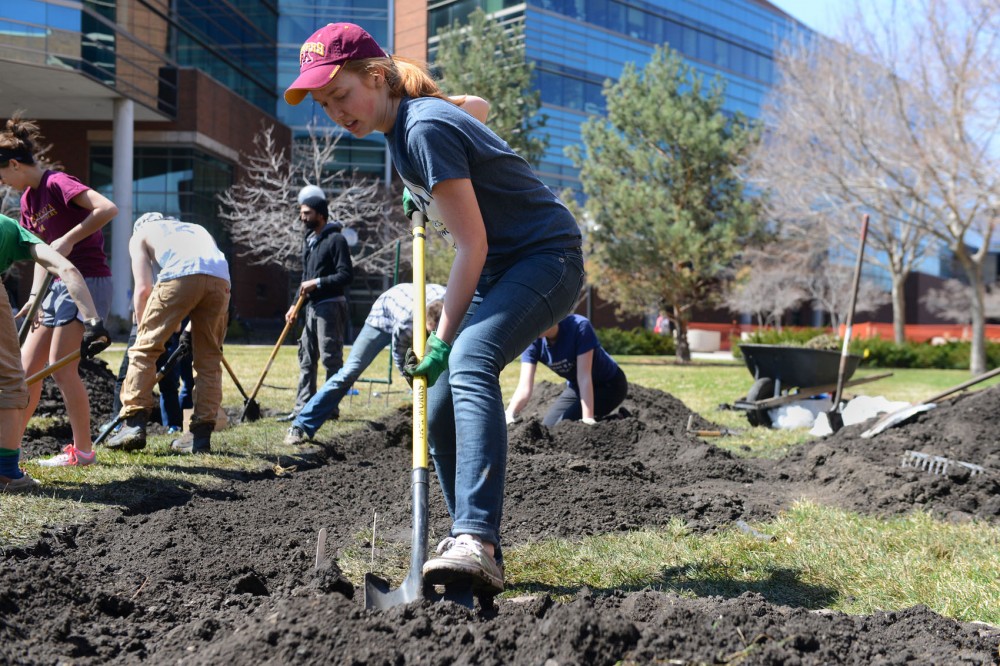Dozens of students and community members gathered with shovels, rakes and hoes on Saturday to convert an unused lawn on the West Bank into a new community garden.
Located between the University of Minnesota’s Wilson Library, Carlson School of Management and the Rarig Center, a vacant piece of land is being repurposed to grow plants as part of an effort to teach students and faculty members about sustainability.
By converting the land, students and community members behind the project also hope to increase area residents’ access to affordable, healthy food and strengthen the campus community’s connection with the Cedar-Riverside neighborhood.
“There’s a lot of unused lawn space that, for some reason, seems to be an aesthetic norm, and I don’t see why that’s the case on campus,” said Louis Mielke, an environmental science junior and the president of Students for Sustainability. “This was mainly showing people that we can use University land in a different way.”
The University made it a goal in 2009 to begin using campus land as a “living laboratory” for research, demonstrations and hands-on learning.
University Facilities Management sustainability coordinator Stacey White said the West Bank Community Garden is one of about 10 living laboratories across campus, including the Monarch Lab and Bee Lab in St. Paul.
White, who has been working with Mielke and other students to find resources for the garden, said this living laboratory is different from others because it has a lot of off-campus backing.
“What’s unique is that there is a lot of support from business owners and community members on the West Bank,” she said. “It’s a great web of support they’ve built.”
Mielke said some owners of restaurants in the Cedar-Riverside neighborhood have contacted him about growing herbs for their businesses on the land.
And aside from growing food, leaders of the garden plan to use its space for sustainability presentations and educational sessions for children at nearby schools, such as the Cedar-Riverside Community School.
Music senior and garden coordinator Justin Halverson said he hopes the project inspires others to start thinking about ways to use University land beyond just providing a space that is aesthetically pleasing.
“Lawn can look nice, and it can function as a nice place to get outside, chill and throw a Frisbee or have a picnic,” he said, “but it really doesn’t serve many practical functions for us.”
Plants in the West Bank Community Garden will provide food for the community and a habitat for pollinating insects, Halverson said.
Political science sophomore Kristen Anderson heard about the garden from a friend in Students for Sustainability, the group responsible for starting the project. She volunteered for about eight hours at the garden’s groundbreaking.
“It’s a unique project that I’m happy to support and start,” Anderson said. “You hear about community gardens, but the ‘U’ hasn’t had one until now.”
The Minnesota Department of Health set aside funding as part of its Statewide Health Improvement Program to increase the state’s number of community gardens.
But despite the state’s support, Mielke said it was still hard to find a space close to campus for students to join.
The idea for the garden began when Students for Sustainability was looking for a new project last fall, he said. One student suggested starting a rain garden on campus, but the group decided to start work on a fair share community garden instead, taking inspiration from another
Minneapolis garden with a similar model.
They received a $3,000 grant last year from the University Institute on the Environment to implement the project.
With the fair share model, anyone working on the garden has equal ownership of the land and what’s growing on it, rather than each person owning a small lot within the land.
“We feel like with having a fair share model, then everyone feels responsible for the garden,” Mielke said, “as opposed to one person only being responsible for their plot.”
The group collaborated with Students for Design Activism to develop the landscape architecture design for the garden. And community donors provided other resources, such as soil, seeds and tools.
Mielke said the group wanted to have a tool shed or a bench on the property, but it would have to go through the grant process again to gain the funding. So, he said, the garden will operate without the extra amenity for now.
But there is plenty of room for more possibilities in the future, Mielke said, especially because the garden only uses half of the campus land provided by the living laboratory program.
“I’m looking forward to expanding this onto different parts of campus that aren’t being used to the fullest potential that they could be,” he said.


